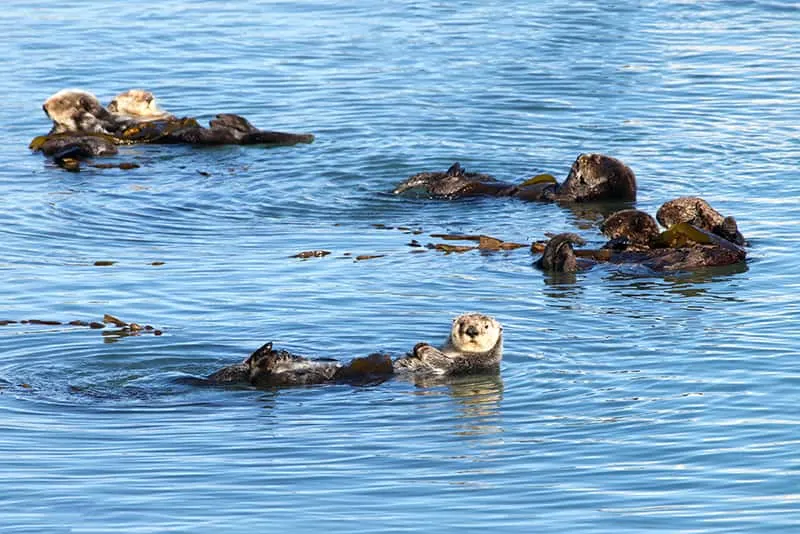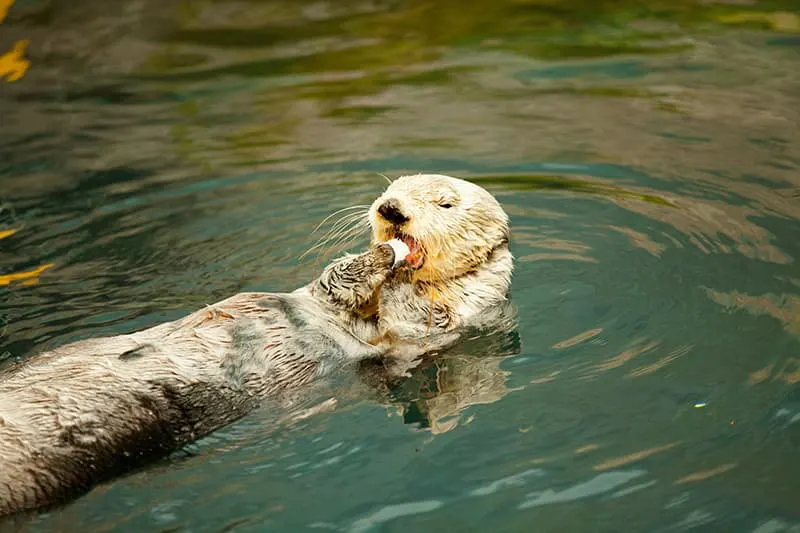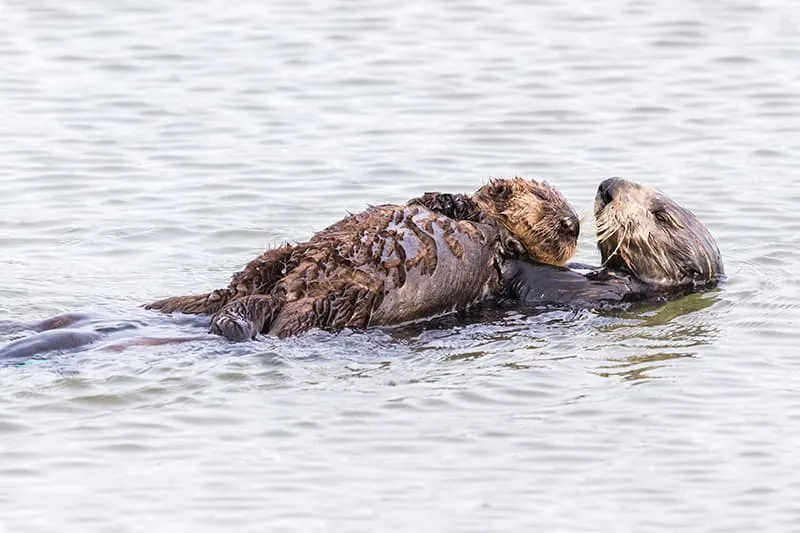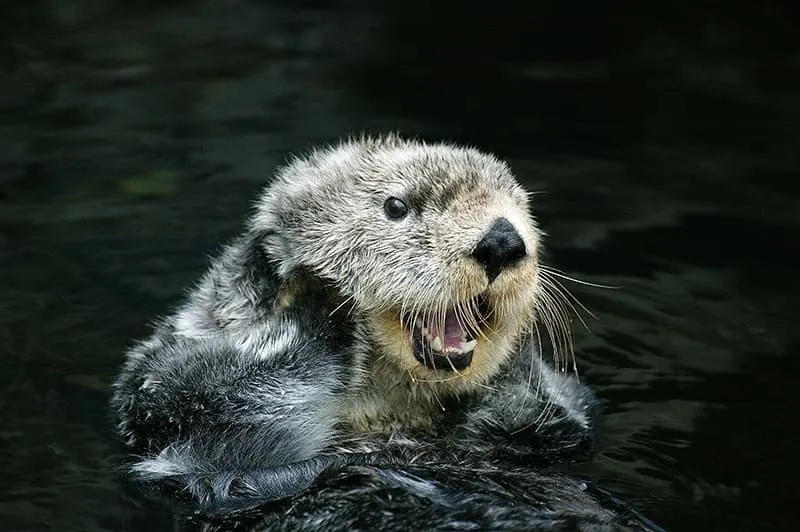Want to learn some fun sea otter facts for kids? You’ll find them in this post. We’ll talk about their physical description, diet, offspring, and more!

Physical Description
A sea otter has a long body and an oval-shaped head with tiny ears. It has two eyes, a blunt snout, and long whiskers. The sea otter is covered entirely with thick, brown fur. Sea otters have four short legs with webbed paws. Their front feet have tiny claws. Sea otters also have a very long tail.
Sea otters can grow to be four to four and a half feet long, including their tail. They can weigh anywhere from forty-six to sixty-two pounds.
Habitat
Sea Otters live in marine habitats along the coastlines of North America and Asia. They can be found along some shores of Japan and on part of the Russian coast. They can also be found along the Pacific coast from Alaska to California state.
Sea otter habitats include different kinds of shallow coastline habitats. Sea otters live in a kelp forest habitat along the Pacific coast of North America. Rocky shores, sandy areas, and coastal wetlands are also habitats that sea otters can be found in.

Habits
Sea otters are social creatures that live in groups. Males and females live in separate groups. Genders typically don’t mix. Sea otters spend most of their time in the water, floating on their backs. They are active both during the day and night.
Sea otters spend their time grooming, foraging for food, and resting. Sea otters need to groom constantly to survive. If their fur becomes dirty, it won't remain waterproof. Sea otters wrap themselves in kelp when they rest or sleep to keep themselves from floating away.
They forage for prey by diving to the ocean floor and gathering small marine animals. They put these in their skin pockets under each front leg. This allows them to carry groups of prey to the surface. Sea otters communicate with each other using a variety of sounds. Their vocalizations include coos, growls, and whistles.
Diet

Sea otters are carnivores. They have a range of more than fifty types of marine animals that they eat. A sea otter has a favorite prey that it eats the most.
The marine animals a sea otter eats include sea urchins, clams, crabs, sea stars, and squid. Sea otters get most of the water they need from the prey they eat. If they need extra water, sea otters will drink seawater.
Offspring
Once a female sea otter is about five years old, she can get pregnant at any time of the year. She carries her baby for six months to a year before giving birth. Mama sea otters give birth to their pup in the water.
When the pup is born, it is about two feet long and weighs five pounds. Pups have a thick coat of baby fur and are blind when they are born. The mama carries the baby on her tummy to keep her baby warm and safe. A sea otter pup nurses for about two months.
The mama sea otter leaves her pup floating in the water when she dives for food. Sometimes she will wrap the pup in kelp. The kelp keeps the pup warm and prevents it from drifting away.
The otter pup starts diving and foraging for food at about two months old. A mother otter stays with her pup from six to twelve months. When the juvenile otter becomes self-sufficient, it joins the group of its gender.

Classification/Taxonomy
Kingdom: Animalia
Phylum: Chordata
Class: Mammalia
Order: Carnivora
Family: Mustelidae
Genus: Enhydra
Species: Enhydra lutris
History
Scientists believe sea otters evolved from their ancestor about five to seven million years ago. The modern sea otter evolved about two million years ago. It is believed that the sea otter first appeared near Japan and Russia.
Predators
The main natural predators of sea otters are great white sharks, orcas, and sometimes sea lions.
Lifespan
Male sea otters typically live ten to fifteen years in the wild. Female sea otters in the wild live a little longer than males. Females live from fifteen to twenty years. Sea otters in captivity typically live well past twenty years.

What Sound Does a Sea Otter Make?
Click on this audio file to hear what a sea otter sounds like.
25+ Unusual Sea Otter Facts for Kids
- A group of resting sea otters is called a raft.
- Sea otter rafts can have from 10 to 1000 members.
- Sea otters don't need to migrate in winter because their fur keeps them warm.
- Female sea otters are called sows, and male sea otters are called boars.
- A sea otter group is called a family, bevy, lodge, or romp.
- Sea otters sleep about eleven hours a day.
- Sea otters need to eat about 25% of their body weight each day.
- A large male sea otter can eat about 25 pounds of food a day.
- Male sea otters are larger than female sea otters.
- Sea otters use rocks as tools to open their shelled prey.
- A sea otter’s kidney allows it to extract fresh water from salt water.
- Sea otters’ ears and nostrils close when they dive under water.
- A sea otter pup grows its waterproof adult fur at about 3 months old.
- Sea otters hold each other’s paws to keep them warm and to avoid drifting away from their raft.
- Sea otters are the only type of otter that gives birth in the water.
- Sea otters mate for life.
- A female sea otter will adopt a baby sea otter that has lost its mother.
- The oldest recorded age of a wild sea otter lived to be 23 years old.
- The oldest sea otter in captivity lived to be 28 years old.
- Alaska is home to roughly 90% of the world’s sea otter population.
- Sea otters almost became extinct in the 1900's due to the fur trade.
- Sea otters are listed as endangered on the IUCN Red List.
- Sea otters are a keystone species because they control the sea urchin population.
- Sea otters have good eyesight and a good sense of smell.
- Sea otters can swim up to 5 miles per hour, which is almost twice as fast as the average human.
- The fur of a sea otter is thicker than that of any other animal.
- Sea otters can hold their breath underwater for five minutes.
- Sea otters have sharp teeth and a powerful bite.
- Sea otters are one of the few mammals that use tools.
- Sea otters are the only marine mammals that can flip over boulders on the ocean floor.
- A sea otter is the only marine mammal that catches fish with its paws instead of its mouth.
- Sea otters can have up to a million hairs per square inch.
- Female sea otters stay within a home range of ten to twenty miles.
- Male sea otters stay within a home range of two miles.
We hope you enjoyed learning all about sea otters! Did you learn anything new? Let us know what other facts you know about them. We can’t wait to find out more.
Here are some other fun mammals that you might want to learn about.
